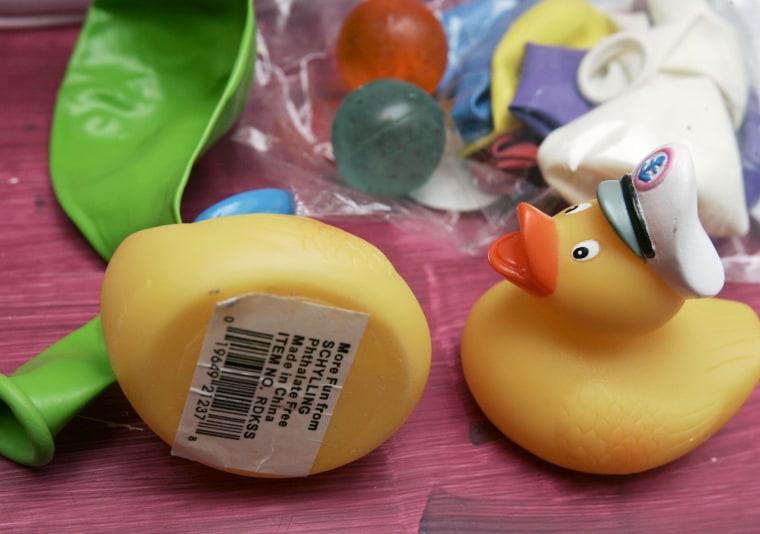
Policies meant to protect people from suspect chemicals in toys and other plastics that have caused widespread public concern reduced levels of some of those chemicals in people’s bodies, researchers reported Wednesday.
But other, equally suspect chemicals replaced them, and it’s not at all clear whether cutting the chemicals, called phthalates (pronounced THAL-ates), has any health benefit at all.
"We were excited to see that exposure to some of the phthalates that are of public health concern actually went down," said Ami Zota, assistant professor of environmental and occupational health at the George Washington University School of Public Health and Health Services.
“Unfortunately, our data also suggest that these are being replaced by other phthalates with potential adverse health effects.”
Phthalates are all over the place – in cosmetics, plastics and even in the air. They help make plastic pliable and they can help make fragrances stick to your skin or other surfaces.
Animal tests suggest they may be endocrine disruptors – hormone-altering chemicals that might raise the risk of birth defects or diabetes. A few human studies also suggest it’s possible, but what isn’t clear is whether people have enough of these chemicals in their body to do any harm, or whether the chemicals are actually causing any harm.
Despite the uncertainty, in 2008 Congress banned three types of phthalates — DEHP, DBP, BBP — in children's toys and items such as pacifiers, and temporarily banned three others.
It is not clear if removing the chemicals also removes any danger.
It also wasn’t clear if it was even possible to lower the dose, because the chemicals are indeed everywhere. People may breathe them in from dust, soak them into their skin or ingest them on food prepared or stored in plastic containers.
Zota, who was formerly at the University of California, San Francisco, and colleagues set out to see. They looked at data from a big study the Centers for Disease Control and Prevention is doing in which scientists sample and test the blood and urine of tens of thousands of Americans.
“Every two years they actually measure exposures to environmental chemicals in urine and blood,” Zota said in a telephone interview.
They looked at changing levels of eight phthalate chemicals in 11,000 people from 2001 to 2010. Levels of three chemicals banned from children’s toys – called BBzP, DnBP and DEHP – went down, Zota’s team reports in the journal Environmental Health Perspectives. But levels of three others went up: DnOP, DiDP and DiNP.
Levels of one phthalate called DEP, which hasn’t been restricted at all, fell 42 percent between 2001 and 2010, while levels of another, called DiBP, tripled. DEP was widely named in campaigns to reduce levels of phthalates in cosmetics, and many companies agreed to change their formulations to meet consumer demand.
Zota says the only question the study can really answer is whether people can change the chemicals they are exposed to, both with policies and with consumer pressure, and the answer is yes.
“We were not evaluating any health outcomes in this study," she said. “We also were not evaluating if the chemicals were present at above or below a health safety threshold because those numbers are constantly changing and there is a lot of debate about whether there are any useful numbers to use as thresholds.”
Most of the evidence about phthalates is circumstantial. Women with the highest levels or certain phthalate byproducts in their urine had a much higher risk of pre-term birth, one study showed. But it is not clear whether the women in fact were exposed to more phthalates, or whether their bodies somehow processed them differently. And it wasn’t clear if it was the phthalates themselves that caused the early births.
Another study published last August showed that children exposed to one of the phthalates and another chemical called bisphenol A were more likely to be obese or show symptoms of diabetes precursors than those with lower exposure.
Scientists working to test the safety of chemicals say it is very hard to determine if a specific chemical is harmful because people have so many circulating in their bodies. Is it the chemical that is harmful, or something else that causes it to build up in the body? And other factors, such as obesity and a lack of exercise, may play a bigger role in reducing fertility and raising the risk of diabetes in both men and women, studies suggest.
Nonetheless, in September, the American College of Obstetricians and Gynecologists (ACOG) and the American Society of Reproductive Medicine (ASRM) issued a call for doctors to do more to help patients reduce their exposure to chemicals such as phthalates and BPA.